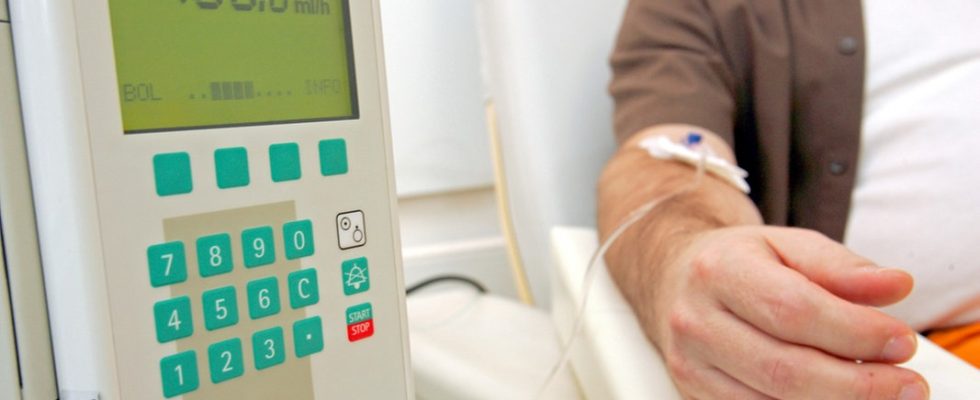As of: January 15, 2024 6:31 p.m
Chemotherapy may be necessary for skin lymphoma.
Malignant lymphomas belong to a group of malignant diseases that originate from the body’s immune cells (lymphocytes). At a Cutaneous lymphoma accumulate under the skin degenerated lymphocytes, grow uncontrollably and cause lymphomas – malignant tumors that destroy the skin. It is not known why the cells degenerate and why they trigger skin lymphoma. A rare type of skin lymphoma that can disguise itself as psoriasis is called Mycosis fungoides.
What types of lymphoma are there?
Both primary cutaneous lymphomas In 65 percent of cases it is so-called T-cell lymphomas. So-called are rarer B-cell lymphomas with a proportion of around 25 percent and other types of lymphoma. There are fast growing (aggressive) and slow growing (indolent) lymphomas.
As opposed to systemic lymphomawhich develop in the lymph nodes and can spread rapidly throughout the body, primary cutaneous lymphomas, which first appear on the skin, often have a better prognosis for recovery.
Examinations for the diagnosis of skin lymphoma
Specialists in dermatology or hematology and oncology are the right contacts for the diagnosis of cutaneous lymph. These examinations are usually the first step:
- Blood, ultrasound and x-ray examinations
- Tissue sample (biopsy) with assessment by a specialist (specialist in dermatohistology or pathology)
If the suspicion of skin lymphoma is confirmed, further examinations will be carried out Spread of the disease detected in the body.
Treatment with various therapies possible
Several treatment options, which are often combined, have proven effective for the treatment of skin lymphomas:
- With Cortisone ointment, which is applied to the affected areas, stronger therapies can be avoided or delayed. Short-term use is usually free of side effects. Cortisone ointment is mainly used in the early stages of mycosis fungoides. Cortisone is rarely injected directly into a tumor because it can be painful. Cortisone can also be administered as a tablet or infusion as part of chemotherapy.
- In the so-called Phototherapy The skin lymphoma is irradiated with UVA light. A special drug, the photosensitizer psoralen, can increase the effect by making the body more sensitive to UVA light. The combination of a photosensitizer with UVA radiation is also called photochemotherapy or PUVA (psoralen-UVA).
- The Extracorporeal photopheresis (ECP) is a type of “blood washing”: the affected person’s blood is separated into red and white blood cells. The white blood cells are irradiated with UVA light and then all cells are returned to the systemic circulation. The procedure is only offered in specialized centers.
- Soft X-rays or fast electrons are particularly suitable for treating individual, clearly defined skin lymphomas. A tube is placed on the skin through which the radiation is emitted. For example, radiation may be used after the lymphoma has been surgically removed.
- Various medications are available for so-called systematic therapy: Interferon alpha and Bexarotene are considered the standard therapy for T-cell lymphomas of the skin worldwide. They are particularly effective in combination with PUVA phototherapy or extracorporeal photopheresis. Interferon alpha is a natural protein that is released by the body during viral infections, among other things, and stimulates the immune system to fight viruses or cancer cells. It is injected into the subcutaneous fatty tissue (subcutaneously). The substance Bexarotene is chemically related to vitamin A and is also known as a retinoid. The drug causes cancer cells to die.
- At the Antibody therapy The artificially produced antibody Rituximab destroys the cancer cells. The medication is administered as an infusion into the vein or can also be injected directly into the lymphoma (intralesional).
- At the chemotherapy A distinction is made between the use of a single substance (monochemotherapy) and the combined use of several substances (polychemotherapy). One Monochemotherapy usually comes in tablet form. Intravenous chemotherapy is used if the skin changes are severe or the tumor burden is high. In advanced stages of skin lymphoma, combined chemotherapy is required.
- One symptomatic therapy It does not treat the disease itself, but rather symptoms such as the excruciating itching (pruritus), which can severely affect those affected. In stubborn cases it is necessary to combine creams and tablets.
Experts on the topic
Further information



